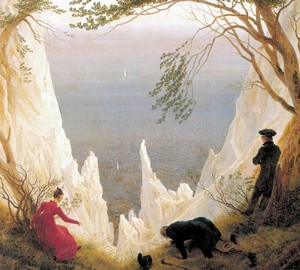
Description of the picture:
Chalk cliffs on the island of Rugen – Caspar David Friedrich. 1818. Oil on canvas. 90 x 71 cm
Usually in the paintings of Caspar Friedrich there is always a hero turned his back to the viewer, and in the work “Cretaceous Rocks on the Island of Rugen” we see three figures at once, looking at the boundless sea. The painter introduced the character, hoping that the viewer would take the place of the hero and “be present” on the canvas in this way. Here we can “try on” three images at once: an admired woman in a red dress, a pensive man on his right, crossed his arms over his chest (some take this pose as a praying pose), and the most curious person who is on his knees, getting close to the edge rocks to see the foot of the chalk ledges.
The picture can be distinguished into two parts – the near and far plan. The particular depth of the canvas is emphasized precisely by the combination of the near and far plans. Everything that is in the immediate vicinity of the viewer is written in great detail and detail, with clear contours and contrasts. But the landscape that the chalk cliffs reveal is more vague, as if through a veil. This boundless expanse of sea goes far beyond the horizon and is written so emotionally with light-air subtleties that one cannot but recall the paintings of the impressionists. How many colors are there and the finest nuances! The greenish water off the coast turns smoothly into saturated blue, then darkens, indicating the deepest areas, so that closer to the horizon it turns into pale pink shades. A special charm to the sea landscape is given by the “frame” – broken whimsical lines of chalk cliffs.
The composition of the canvas is distinguished by harmony and poise. Rocks protrude on the sides, revealing a magnificent view of the sea, and from above all are crowned by trees that leaned towards each other, almost weaving branches among themselves. Some critics explain the presence of trees as a hint of a strong and emotional union of the artist and his wife.
Only the most attentive eye will be able to make out two sailing ships among the sparkling waves bathed in the sun. From this, the sea expanses seem even more magnificent.
The coloristic solution of the work is very rich. This is one of Caspar Friedrich’s most colorful paintings – brown, deep green, blue and red (heroine’s dress), sparkling white (rocks) appear in bright contrasting spots.
A special mood creates sunlight. Many of Frederick’s works are cloudy, excited, and here we see a clear sky, creating a serene mood."